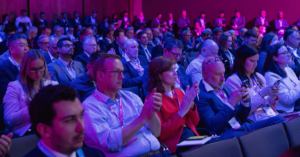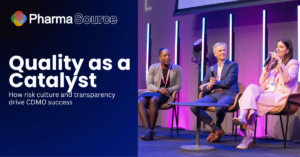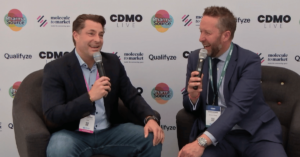“When you’re building something at the edge of science, it’s crucial to start with the problem, not the solution. My team has created 15 pharma startups using this approach, and 14 are still alive.” – Kerstin Papenfuss, Director of Pharma at Deep Science Ventures
Kerstin Papenfuss serves as the Director of Pharma at Deep Science Ventures, where she leads the creation and development of novel therapeutics for unmet medical needs. With a PhD in Tumour Immunology from Imperial College London and an MBA from Bayes Business School, Kerstin brings over a decade of experience in oncology, signal transduction, and pharmaceutical markets to her role building science-based startups from scratch.
In the latest PharmaSource podcast, Kerstin explains why traditional approaches to biotech startup creation often fail and how working from first principles can lead to more successful, impactful ventures. Her experience spans working with entrepreneurs, academics, pharmaceutical companies, and disease charities to build companies that solve fundamental challenges in healthcare.
Starting with the Problem, Not the Solution
Kerstin’s approach at Deep Science Ventures (DSV) begins by identifying significant healthcare problems before developing solutions, rather than starting with a technology and searching for applications.
“Academia is driven by novelty, but they often don’t consider how to scale up. When they finally reach that point, they realise the market isn’t there or the economics don’t work,” Kerstin explains. “What we do at DSV is take an indication and work out exactly what the state of the art is, not just at this point in time but also predicting what it will be in a few years when the solution becomes relevant.”
This reverse-engineering approach helps DSV identify the constraints that limit current solutions – whether they’re related to health economics, payment models, technology limitations, or intellectual property. By mapping these constraints broadly, DSV can develop solutions designed to work within real-world limitations.
“The scientists we look for need to be very good at first principles thinking because that’s what we do with them. They help us develop the whole proposal. We pick people who think this way naturally.”
Breaking Assumptions to Create Breakthrough Companies
One of DSV’s key strategies is identifying and challenging fundamental assumptions that constrain innovation. By “flipping constraints,” they unlock entirely new solution pathways.
“As soon as you manage to break or flip a constraint, that unlocks a whole new solution that nobody has ever thought about,” says Kerstin. She offers the example of Deliver Bio, a company DSV created in 2017.
“Everyone had realised that the autologous manufacturing process for CAR-T was probably going to be too expensive to scale into mainstream applications. Most companies were trying to develop allogeneic approaches. But we asked: ‘Does manufacturing have to happen outside the body? What if you could do this inside the body?'”
This first-principles question led to transforming CAR-T from a cell therapy approach into a gene therapy approach – something available off-the-shelf that could dramatically reduce manufacturing costs and enable mainstream market access.
Another example is Plurify, developed with the Cell and Gene Therapy Catapult to solve a critical challenge in regenerative medicine: ensuring cell purity. Rather than using conventional sorting technologies that don’t scale, DSV asked: “Wouldn’t it be nice if the cells themselves could realise they were the wrong cell type?”
“We ended up with a neat synthetic biology solution that exploits biomarkers together with a modality that doesn’t hang around to selectively eliminate unwanted cells in a completely scalable way,” Kerstin reveals. “It addresses a major industry bottleneck, which is why the company is already getting significant inbound interest.”
Building Effective Collaborations and Teams
DSV’s startup creation model relies heavily on strategic partnerships with organisations that have deep subject matter expertise in specific problem areas, whether they’re disease charities, industry partners, or research institutions.
“We love working on problems with people who have an in-depth understanding of that problem. That’s how we pick our partners,” Kerstin notes. “We at DSV are generalists. We have a really good understanding of the edge of biotech as a whole, but we aren’t detailed experts in specific problems. We just like to ask really good questions.”
These partnerships provide multiple advantages:
- Access to subject matter experts and key opinion leaders
- Valuable datasets that partners may not know how to fully exploit
- Networks of talented scientists eager to start companies
- Potential acquisition opportunities for pharma partners
For early-stage startups, Kerstin emphasises the importance of openness and collaboration: “The people who are a little bit more open and pay it forward are the companies that actually move the quickest. Those in our network who were too hesitant about talking broadly are the ones that are a little bit more behind.”
The Future of Cell and Gene Therapy Innovation
Despite the current “trough of disillusionment” in cell and gene therapy, Kerstin remains optimistic about its transformative potential. She sees the current challenges as typical of innovation cycles.
“In innovation, you always have this first wave where people identify things that could massively move the needle, everyone jumps on it, and then these first-generation approaches run into problems. We’ve just seen the first generation of cell and gene therapies,” Kerstin observes.
For cell and gene therapies, these problems include limited duration, lack of repeat administration options, and high costs. Kerstin believes we’re just scratching the surface of what’s possible, particularly in using cells as “data generation and integration machines.”
“At the moment, we’ve just been exploiting this in the context of CAR-T, where it sees a cancer antigen and triggers a kill circuit. But there are loads of other functions we could be triggering, loads of other cell types we could be using. With the understanding we now get through single-cell analysis throughout the body in different indications, we’ll get a much better understanding of what individual cell types do and how we could potentially change them.”
Practical Framework for Biotech Entrepreneurship
To transform DSV’s approach into actionable steps, here’s a detailed framework for scientists looking to build impactful startups:
1. Problem Identification and Mapping
Start by defining constraints: “We map constraints including path economics, who will pay, technology edge, and IP landscape. Then we try to develop solutions within these constraints.”
Set outcome targets: “Define what metrics you would need to hit to compete in the market when your solution becomes relevant, not just today.”
Aim for curative approaches: “Work on solutions that are mechanistically capable of addressing the cause of disease, not just managing symptoms. That fundamentally changes the health economics equation.”
2. Building Your Founding Team
Technical expertise is just the beginning: “We always look for technical expertise, but we’re also looking for people who will thrive in the startup environment—being able to deal with uncertainty, showing resilience, and being magnetic because you need to raise money and convince people to join your team.”
Complement core skills: “Once we understand the best solution, that usually requires bringing in complementary expertise. We help with recruiting that complementary co-founder.”
Create diverse teams: “The most inspiring conversations aren’t always with the grey-haired PI on the slide deck. Often it’s with the post-docs who’ve moved from one field to another and apply their knowledge cross-disciplinary.”
3. Practical Funding Strategy
Start with non-dilutive funding: “DSV companies have a really good track record of getting Innovate UK funding. Use these resources before seeking venture capital.”
Align value inflection with IP strategy: “Have a proof-of-concept plan for the idea tied in with a fundraising strategy where you have value inflection points at the right stages.”
Bring advisors strategically: “Bring in advisors that make your team look incredible in front of investors, then provide the pre-seed money to get this off the ground.”
4. Maintaining Lean Operations
Operate virtually when possible: “You can pull quite a lot together that looks like a good company without having premises while maintaining lean operations.”
Leverage accelerators strategically: “In the UK, you have accelerators that provide free lab space, come with their networks, and provide non-dilutive funding.”
Build strategic collaborations: “Use partners to gain access to subject matter experts and key opinion leaders. It’s much easier to get them on the phone if a charity or established organization makes the introduction.”
5. Managing IP and Confidentiality Pragmatically
Balance openness with protection: “It is always possible to find a way to communicate without disclosing too much but still having meaningful learnings.”
Use staged disclosure: “We typically reach out to get feedback at a level that doesn’t give too much away but gives just enough. If the person is interested and helpful, then we’ll sign a CDA.”
Time your conversations strategically: “If I’m talking to somebody that has the potential to acquire my company and has the expertise to recreate my solutions, I might want to wait until I have my ducks in a row and my IP filed.”
While acknowledging the unique innovation ecosystem in the UK that sits between the risk-averse culture of continental Europe and the failure-embracing approach of the US, Kerstin emphasises that Deep Science Ventures’ model is fundamentally about addressing constraints and building solutions from first principles – an approach that produces startups with stronger foundations and better chances of success.
“If I were to create a startup and then fail in Germany, I’d be seen as a failure,” Kerstin notes. “I think we have a very different culture here in the UK, not quite as out there as in the US, but probably somewhere in the middle that actually celebrates people who try something new.”












 Stay ahead of trends and best practices
Stay ahead of trends and best practices
